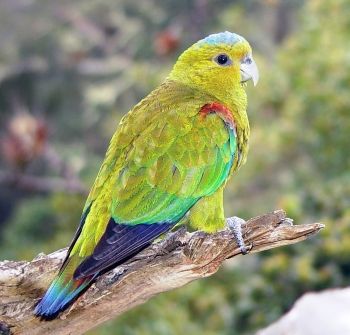
Publisher:
Bonnie King
CONTACT:
Newsroom@Salem-news.com
Advertising:
Adsales@Salem-news.com

~Truth~
~Justice~
~Peace~
TJP
Oct-20-2010 17:11

 TweetFollow @OregonNews
TweetFollow @OregonNews
Conservation Scientists Release Global Strategy to Halt Extinctions
Salem-News.comNations are meeting to decide the future of biodiversity.
 Fuertes Parrot. Photo: Fundacion ProAves –AZESpecies |
(WASHINGTON D.C.) - Sixty-eight biodiversity conservation institutions from twenty countries aligned in the Alliance for Zero Extinction (AZE) today released new data that pinpoint 587 single sites where 920 of the world’s most endangered wildlife species are restricted—places that if properly protected could help to avert an imminent global extinction crisis.
The AZE data are accompanied by a map that graphically illustrates the location of each of the sites around the world. The new data result from the efforts of a network of hundreds of scientists and conservationists around the world.
“AZE enables us to instantly pinpoint the locations of the world’s key wildlife extinction epicenters. It allows us to see at a glance where we need to focus efforts to prevent imminent extinctions and preserve Earth’s precious biodiversity,” said American Bird Conservancy Vice President and AZE Chair Mike Parr.
At the present time, only half of the sites identified enjoy any formal protection, and of those, half are only partially protected. “Protecting the remaining unprotected AZE sites, through locally appropriate means, is an urgent strategic global biodiversity conservation priority” added Parr.
“Identifying where species are at greatest risk will help all of us engaged in the fight to save biodiversity” said Ahmed Djoghlaf, Executive Secretary of the Convention on Biological Diversity. “AZE is a key partner in implementation of the Convention and the achievement of the soon to be adopted Aichi-Nagoya Strategic Plan. This is why we found it important to establish a memorandum of cooperation with them. This is why they are a key partner.”
The new AZE data and map are being released in conjunction with the October 18-29 conference of the parties to the Convention on Biological Diversity, in Nagoya, Japan which includes 193 of the world’s countries. Together, these conservation tools represent a straightforward means for countries and international donors such as the Global Environment Facility and the World Bank to cost-effectively address the issue of imminent and predictable species loss, a central component of biodiversity conservation.
AZE was formed in 2000 to further efforts to prevent imminent species extinctions by identifying and safeguarding the places where species evaluated to be Endangered and Critically Endangered by the IUCN (International Union for the Conservation of Nature) for inclusion on their Red List of Threatened Species, are restricted to single remaining sites. To date, AZE has identified sites for mammals, birds, amphibians, reptiles, conifers, and reef-building corals, providing a tool to defend against many of the most predictable species losses. Country-based initiatives, representing partnerships of government agencies and non-government organizations, have been developed in Brazil and Colombia to accelerate the protection of AZE sites. Other countries, such as Mexico and Peru, are in the process of developing similar initiatives.
Protecting an AZE site can often prevent multiple extinctions, as some of these sites host more than one highly threatened species. Studies show that AZE sites are particularly important for providing ecological services too, so their protection brings an even wider range of benefits.
“Urgent action to safeguard these sites makes sense in so many ways,” said Parr. “Decisions taken at the Nagoya meeting need to provide the momentum to make this happen.”
The sites with the most AZE species are the Sierra de Juarez with 22 species, and Veracruz Volcanoes with 16 species, both in Mexico. Massif de la Hotte, Haiti is third with 15 species, followed by Sierra Nevada de Santa Marta National Natural Park, Colombia, with 12 species. Japan, the host nation for the Convention on Biological Diversity meeting this month, has six AZE sites, one of which, Yambaru, hosts five AZE species, including the Okinawa Rail and Okinawa Woodpecker. The countries with the most AZE sites are: Mexico (68), Colombia (46), Peru (34), Indonesia (31), Brazil (27), and China (23). Having a large number of sites does not necessarily reflect on a nation’s environmental performance, however, since a disproportionate wealth of biodiversity, such as that found in countries with a broad array of ecoregions in a small range, ultimately poses an extraordinary conservation challenge.
The new map provides an update to AZE’s first global data set that was issued in 2005. To learn more about the Alliance for Zero Extinction, and identify sites in each country, go to: http://www.zeroextinction.org/
American Bird Conservancy and its partners have developed a network of 39 bird reserves throughout Latin America that protect 17 AZE sites, and provide habitat for one-third of all the AZE bird species in the region. These reserves span some 700,000 acres across 12 countries. More than one million trees have been planted in reserve buffer zones and more than 300 conservation-related jobs have been created for people who live nearby.
Source: American Bird Conservancy
Articles for October 19, 2010 | Articles for October 20, 2010 | Articles for October 21, 2010

Quick Links
DINING
Willamette UniversityGoudy Commons Cafe
Dine on the Queen
Willamette Queen Sternwheeler
MUST SEE SALEM
Oregon Capitol ToursCapitol History Gateway
Willamette River Ride
Willamette Queen Sternwheeler
Historic Home Tours:
Deepwood Museum
The Bush House
Gaiety Hollow Garden
AUCTIONS - APPRAISALS
Auction Masters & AppraisalsCONSTRUCTION SERVICES
Roofing and ContractingSheridan, Ore.
ONLINE SHOPPING
Special Occasion DressesAdvertise with Salem-News
Contact:AdSales@Salem-News.com


Salem-News.com:

Terms of Service | Privacy Policy
All comments and messages are approved by people and self promotional links or unacceptable comments are denied.
[Return to Top]
©2025 Salem-News.com. All opinions expressed in this article are those of the author and do not necessarily reflect those of Salem-News.com.